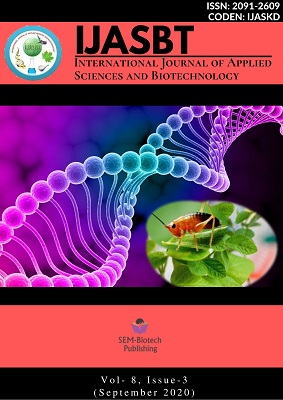Seroprevalence of Chlamydia abortus Among Cattle of Selected Areas in Terai Belt of Nepal
DOI:
https://doi.org/10.3126/ijasbt.v8i3.30235Keywords:
Antibodies, Cattle, Chlamydia abortus, ELISA, SeroprevalenceAbstract
A cross-sectional study was carried out to determine the seroprevalence of Chlamydia abortus in dairy cattle of selected areas in Chitwan, Nawalpur, and Rupandehi districts, Nepal from November to December 2018. A total of 92 serum samples were collected and screened by Indirect ELISA from ID vet. Out of 92 samples, three samples were positive resulting overall prevalence of 3.27%. As there is no practice of vaccination, overall seroprevalence was from natural infection. Significantly (p=0.034) all samples were seropositive from the Rupandehi district. Sero-prevalence was higher in Jersey crosses (4.22%) as compared to Holstein Friesian (HF) crosses (0%) and cattle of age >3 years were found to be more seropositive (6.97%) as compared to cattle of age ≤3 years (0%). There was no statistically significant association of seroprevalence with breed and age group. Thus, the cattle population of Rupandehi District are at high risk of acquiring chlamydia infection. Strict quarantine and good biosecurity can prevent the possibility of a disease outbreak.




